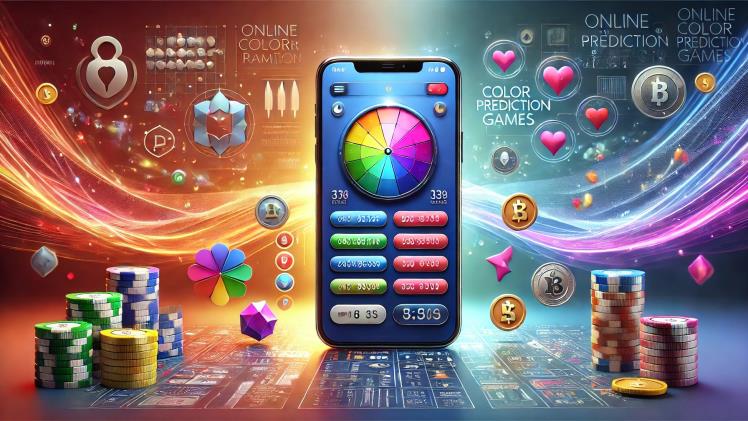Color prediction games have captured the attention of millions worldwide, offering simple mechanics and the thrill of quick rewards. From their vibrant visuals to the anticipation of success, these games have a way of hooking players and encouraging repeated participation. But why do they feel so addictive? The answer lies in the intricate interplay between game design and human psychology.
This article delves into the psychological factors that make color prediction games so compelling and explores how these elements stimulate the brain’s reward system, creating an experience that players find difficult to resist.
1. The Allure of Simplicity
One of the main reasons color prediction games are so addictive is their simplicity. The gameplay requires no complex rules or special skills—players merely predict the outcome of a randomly chosen color. This ease of participation makes the games accessible to a wide audience, including those who might not typically engage with more challenging or time-intensive games.
From a psychological standpoint, this simplicity lowers cognitive barriers, allowing players to dive in without overthinking or feeling intimidated. The immediate gratification of a quick win reinforces the behavior, making players more likely to play again.
2. The Role of the Brain’s Reward System
The human brain is wired to seek rewards, and color prediction games capitalize on this natural tendency. At the core of this process is dopamine, a neurotransmitter that regulates feelings of pleasure and motivation.
How Dopamine Drives Addiction:
- Anticipation: The moment players place their bets, their brains begin anticipating a reward, triggering a dopamine release. This feeling of anticipation is inherently pleasurable, even before the outcome is revealed.
- Winning Moments: A correct prediction leads to an even greater surge of dopamine, creating feelings of joy and accomplishment.
- Chasing the High: Players who experience a loss often return to the game seeking the dopamine “high” associated with winning. This cycle of anticipation and reward keeps players engaged, even after setbacks.
The unpredictability of outcomes amplifies the effect, as players are drawn to the excitement of not knowing what will happen next.
3. The Impact of Variable Rewards
Color prediction games employ a psychological principle known as variable ratio reinforcement, where rewards are delivered unpredictably. This is the same mechanism that makes slot machines and lotteries so compelling.
Why Variable Rewards Work:
- Uncertainty Increases Engagement: Players are motivated to keep playing because they never know when the next win will occur. The possibility of a big payout, even if rare, sustains their interest.
- Reinforcement of Behavior: Each win reinforces the behavior of playing, creating a feedback loop that encourages further participation.
The intermittent nature of rewards makes every game session feel like it could be the “lucky one,” driving players to continue betting despite losses.
4. Emotional Triggers and Impulsivity
Color prediction games are designed to evoke strong emotional responses. Winning triggers feelings of elation, while losing can create frustration or disappointment. These emotional highs and lows fuel impulsive behavior, such as chasing losses or doubling down on bets.
Emotional Triggers in Play:
- Winning Streaks: Success creates a sense of momentum, encouraging players to believe they are on a “hot streak” and should keep playing.
- Losses and Recovery: Conversely, losing prompts players to chase their losses in an attempt to recover what they’ve spent. This behavior is driven by the sunk cost fallacy, where players feel compelled to continue because they’ve already invested time or money.
Understanding and managing these emotional triggers is crucial for maintaining a healthy relationship with the game.
5. The Power of Visual and Auditory Feedback
The vibrant colors, flashing animations, and celebratory sound effects in color prediction games are not just decorative—they’re carefully designed to captivate attention and stimulate pleasure.
Psychological Effects of Feedback:
- Colors and Emotions: Bright, saturated colors evoke excitement and energy, enhancing the game’s overall appeal.
- Positive Reinforcement: Sound effects and visual cues associated with winning create a sense of accomplishment, reinforcing the desire to play.
- Immersion: The combination of engaging visuals and sounds creates an immersive experience that keeps players hooked.
6. Social and Competitive Dynamics
Many color prediction games incorporate social features, such as leaderboards or multiplayer modes, which tap into players’ desire for connection and competition. Being able to compare scores or achievements with others adds another layer of motivation, encouraging players to return and improve their performance.
Conclusion: Awareness and Balance
The addictive nature of color prediction games at bdg win login stems from their ability to tap into deep-seated psychological mechanisms, from the brain’s reward system to emotional triggers and variable reinforcement. While these elements create a fun and engaging experience, they can also lead to compulsive behavior if not managed responsibly.
For players, understanding the psychology behind these games is the first step toward maintaining control and enjoying them in moderation. For developers, creating features that promote responsible gaming—such as spending limits or gameplay reminders—can help ensure that these games remain a source of entertainment rather than stress.
Ultimately, the appeal of color prediction games lies in their ability to combine simplicity, excitement, and unpredictability in a way that resonates deeply with human psychology.

